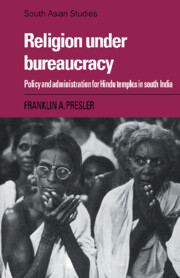Book contents
- Frontmatter
- Contents
- Dedication
- Preface
- Notes on sources, abbreviations and transliteration
- Map
- 1 Introduction: studying religion-state relations
- 2 The temple connection in the nineteenth century
- 3 Governance: the necessity for order
- 4 Governance: trustees and the courts
- 5 Economy: the problem of controlling land
- 6 Economy: the temple's weakness as landlord
- 7 Religion: purifying and organizing Hinduism
- 8 Religion: controlling the priesthood
- 9 Conclusion
- Bibliography
- Index
1 - Introduction: studying religion-state relations
Published online by Cambridge University Press: 03 October 2009
- Frontmatter
- Contents
- Dedication
- Preface
- Notes on sources, abbreviations and transliteration
- Map
- 1 Introduction: studying religion-state relations
- 2 The temple connection in the nineteenth century
- 3 Governance: the necessity for order
- 4 Governance: trustees and the courts
- 5 Economy: the problem of controlling land
- 6 Economy: the temple's weakness as landlord
- 7 Religion: purifying and organizing Hinduism
- 8 Religion: controlling the priesthood
- 9 Conclusion
- Bibliography
- Index
Summary
The past decade has seen a significant change in our perception of the relations of religion and politics. The once widespread belief that modern times would bring the inevitable decline of religion as a force in public life has been profoundly shaken. The interplay of religion and politics seems suddenly again a world-wide phenomenon, affecting both the “developing” world of Asia, Africa, the Middle East and Latin America, and the “developed” world of Europe and North America, and involving all the great religious traditions: Islam, Hinduism, Judaism, Christianity, Buddhism and their various sects. The prominence of religion in public life has reopened a whole set of issues which many people had regarded as closed, such as the role of religion in party politics, public education, family law, taxation, foreign relations and civic morality.
The resurgence of religion poses many challenges to our understanding. As scholars search for explanations, clergy and politicians struggle with the more immediate problem of finding effective ways to address each new controversy as it emerges. Many urge as a basic principle that religion and politics be kept separate, that the health of both church and government can be ensured only when they are allowed considerable autonomy in their respective domains. This separation, it is said, is the only feasible arrangement given the increasing religious pluralism of most societies. But this prescription, however important, has not always been helpful in negotiating satisfactory relations between religion and the state. The problem remains universal, and is apparently intractable.
- Type
- Chapter
- Information
- Religion under BureaucracyPolicy and Administration for Hindu Temples in South India, pp. 1 - 14Publisher: Cambridge University PressPrint publication year: 1988



